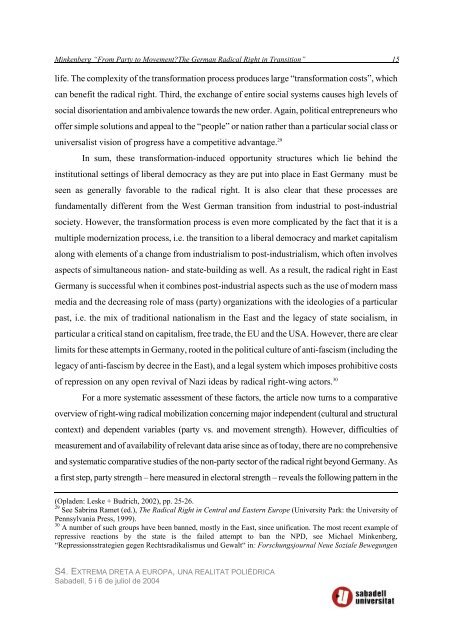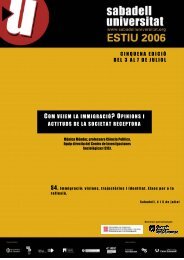From Party to Movement? The German Radical Right
From Party to Movement? The German Radical Right
From Party to Movement? The German Radical Right
You also want an ePaper? Increase the reach of your titles
YUMPU automatically turns print PDFs into web optimized ePapers that Google loves.
Minkenberg “<strong>From</strong> <strong>Party</strong> <strong>to</strong> <strong>Movement</strong>?<strong>The</strong> <strong>German</strong> <strong>Radical</strong> <strong>Right</strong> in Transition” 15<br />
life. <strong>The</strong> complexity of the transformation process produces large “transformation costs”, which<br />
can benefit the radical right. Third, the exchange of entire social systems causes high levels of<br />
social disorientation and ambivalence <strong>to</strong>wards the new order. Again, political entrepreneurs who<br />
offer simple solutions and appeal <strong>to</strong> the “people” or nation rather than a particular social class or<br />
universalist vision of progress have a competitive advantage. 29<br />
In sum, these transformation-induced opportunity structures which lie behind the<br />
institutional settings of liberal democracy as they are put in<strong>to</strong> place in East <strong>German</strong>y must be<br />
seen as generally favorable <strong>to</strong> the radical right. It is also clear that these processes are<br />
fundamentally different from the West <strong>German</strong> transition from industrial <strong>to</strong> post-industrial<br />
society. However, the transformation process is even more complicated by the fact that it is a<br />
multiple modernization process, i.e. the transition <strong>to</strong> a liberal democracy and market capitalism<br />
along with elements of a change from industrialism <strong>to</strong> post-industrialism, which often involves<br />
aspects of simultaneous nation- and state-building as well. As a result, the radical right in East<br />
<strong>German</strong>y is successful when it combines post-industrial aspects such as the use of modern mass<br />
media and the decreasing role of mass (party) organizations with the ideologies of a particular<br />
past, i.e. the mix of traditional nationalism in the East and the legacy of state socialism, in<br />
particular a critical stand on capitalism, free trade, the EU and the USA. However, there are clear<br />
limits for these attempts in <strong>German</strong>y, rooted in the political culture of anti-fascism (including the<br />
legacy of anti-fascism by decree in the East), and a legal system which imposes prohibitive costs<br />
of repression on any open revival of Nazi ideas by radical right-wing ac<strong>to</strong>rs. 30<br />
For a more systematic assessment of these fac<strong>to</strong>rs, the article now turns <strong>to</strong> a comparative<br />
overview of right-wing radical mobilization concerning major independent (cultural and structural<br />
context) and dependent variables (party vs. and movement strength). However, difficulties of<br />
measurement and of availability of relevant data arise since as of <strong>to</strong>day, there are no comprehensive<br />
and systematic comparative studies of the non-party sec<strong>to</strong>r of the radical right beyond <strong>German</strong>y. As<br />
a first step, party strength – here measured in elec<strong>to</strong>ral strength – reveals the following pattern in the<br />
(Opladen: Leske + Budrich, 2002), pp. 25-26.<br />
29<br />
See Sabrina Ramet (ed.), <strong>The</strong> <strong>Radical</strong> <strong>Right</strong> in Central and Eastern Europe (University Park: the University of<br />
Pennsylvania Press, 1999).<br />
30<br />
A number of such groups have been banned, mostly in the East, since unification. <strong>The</strong> most recent example of<br />
repressive reactions by the state is the failed attempt <strong>to</strong> ban the NPD, see Michael Minkenberg,<br />
“Repressionsstrategien gegen Rechtsradikalismus und Gewalt“ in: Forschungsjournal Neue Soziale Bewegungen<br />
S4. EXTREMA DRETA A EUROPA, UNA REALITAT POLIÈDRICA<br />
Sabadell, 5 i 6 de juliol de 2004













